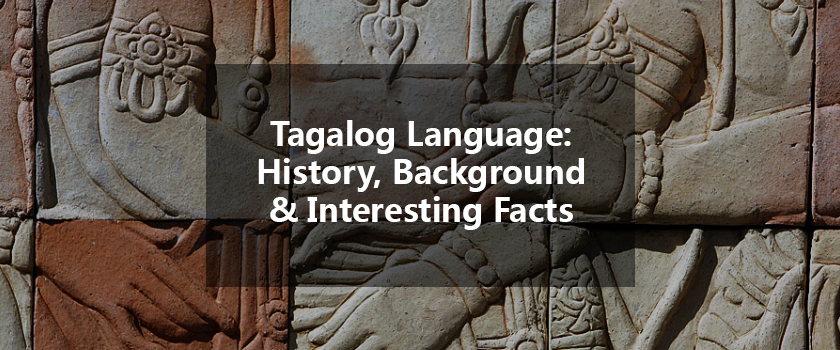Some languages are widely spoken and learned by many people in the world. Tagalog is one such interesting language. Originated in the Philippines islands, it is the first language of most Filipinos and the second language of many others. About 24 million people speak Tagalog worldwide and is one of the most common languages apart from English in the United States. No wonder many businesses are looking for translating to Tagalog.
The wide population of Tagalog speakers makes it one interesting language to learn. Although it originated in the Philippines, it contains traces of English and Spanish. The word “Tagalog” means “from the river”. The language is spoken in China, Spain, and Malaysia influences the Tagalog language. Additionally, it resulted from the occupation of the Philippines by several other countries. Moreover, Tagalog has changed with time due to the influence on the Philippines by other nations.
A Look at the Historical Background of Tagalog Language
According to an estimate, there are approximately 50 million Tagalog speakers in the Philippines. Most of these speakers live in the southern part of Luzon which is the archipelago’s largest island. The official language of the Philippines, Filipino is based on Tagalog. Other languages spoken in the region are Waray-Waray, Pangasinan, Cebuano, Maranao and Kapampangan.
Read : Exploring the Languages Spoken in the Philippines
Other than that, there are also many numbers of Tagalog-speaking communities in other countries. For example, Tagalog is ranked as the sixth most spoken language in the United States. The Tagalog language is an Austronesian language that belongs to the Malayo-Polynesian subfamily. Malay and Chinese languages also influence it. Later, Spanish and American English also influenced it. This is the reason why these languages have influenced Tagalog words and their spellings.
The Writing Script of Tagalog
An ancient script called the Baybayin language influenced the writing system of the Tagalog language. This Baybayin language uses a syllabic alphabet and Spanish colonialists romanized it. Today, the modern alphabet has also changed to incorporate foreign sounds from English and Spanish languages.
Tagalog has borrowed many words from the Spanish language. In urban areas, a mixture of Tagalog and English, the “Taglish” is quite common. English words are used along with words of Spanish origin in spoken and written Tagalog. The interesting thing to observe here is that although some of these borrowed words have equivalent forms in Tagalog, their use is reserved for formal or literary language. Many of the loan words do not have Tagalog counterparts. This is because these words refer to objects which did not exist before the Westerners came.
However, even though Tagalog has borrowed words from foreign languages, the richness of the language is still intact. For example, the language does not easily absorb foreign words and phrases. These words have to get past the complexities of Tagalog’s system of affixes, letters, and syllables. This not only makes it one challenging language, but it also makes it an interesting one.
Interesting Facts About Tagalog
The Tagalog language has some interesting facts that set it apart from other languages.
The Number of Tagalog Speakers
Approximately 27 million people around the world speak Tagalog as a first language. Around 45 million people can speak the Tagalog language when second language skills are added in. It is also a language spoken in Canada and the United States even though the major part of people who speak Tagalog live in the Philippines.
Tagalog spread around the world owing to the number of immigrants over the years. As it spread, it garnered interest among the people. This is the reason why it is commonly learned around New Zealand and Australia. As a result, it estimated that around 24 million people outside the Philippines speak Tagalog. Saudi Arabia, the United Arab Emirates, the United Kingdom, and Guam are other countries where this language is spoken.
The Status of Tagalog as the Official Language
Tagalog became the official language of the Philippines islands in 1879. However, its reign was short-lived. Spanish replaced it as the national language in 1935. In fact, Tagalog cannot be categorized as an actual official language. Filipino is the official language of the Philippines and is essentially a standardized form of Tagalog.
However, in spite of being an official language, only a quarter of the population in the Philippines speaks Filipino. Other languages which are closely related to the Tagalog language are Visayan, Bikol, and Ilocano. Malay, Hawaii, Taiwan, and Maori officially speak these languages.
The Family Language of Tagalog
The Tagalog language is a member of the Austronesian language family. It further belongs to the Central Philippines family of languages. The Pacific Ocean as well as Southeast Asia speak these Austronesian languages. More than 350 million people speak one of the many Austronesian languages. when considered separately.
The Common Dialects of Tagalog
The number of dialects of the Tagalog language is currently unknown. While Filipino is a standardized version of the language, it has other dialects as well. There are basically four common dialects of Tagalog. In the North part of the Philippines, the Bulacan dialect is spoken and Batangas in the Southern part of the region.
Manila dialect is commonly spoken in the Central part of the Philippines while Marinduque is spoken in the Marinduque region. This Marinduque is considered the only dialect among the four ones that differ from the others.
The Learning of Tagalog Language
One interesting fact about the Tagalog language is that it is fairly easy to learn for English speakers. In fact, the Foreign Service Institute (FSI) considers Tagalog as a Category II language. It takes an average of around 1100 hours of lessons to properly learn Tagalog, which roughly takes around 44 weeks of full-time study. Although this language has some big differences from the English language, it is not difficult to learn as compared to other languages in the region.
Tagalog’s Status as Written Language
Tagalog dates back as far as 900 CE as a written language. In fact, Laguna Copperplate Inscription, the oldest Filipino document found in the Philippines, was written in Tagalog. This document was discovered in 1989. Pablo Cain wrote the first Tagalog dictionary in the 18th century.
As time passed, Tagalog incorporated words, pronunciations, and phrases from other languages. As a matter of fact, some Filipinos call the combination of English and Tagalog “Taglish”. Although most Filipinos still speak Tagalog, the younger generations are also learning other Tagalog dialects as well.
Tagalog and the United States
In the United States, there is a myriad of languages. Tagalog is the third most spoken language in the region. The majority of the Tagalog speakers reside in Nevada, California, and Washington. It comes as no surprise, therefore, that many celebrities living and working outside the United States speak this language.
Some examples of celebrities are Allan Pineda Lindo of the Black-Eyed Peas. Famous American actress Meghan Markle (also the wife of Prince Harry of England) speaks Tagalog as well. There are other famous celebrities who speak this language as well.
The Last Word
The Tagalog language is a well-known and widely spoken language in the world. Although it has never gained the status of an official and national language, it has given rise to the Filipino language which is an official language of the Philippines. Learning to communicate and write in Tagalog is actually not a tough task, as many people learn it around the world.
This makes Tagalog one of the languages that are of importance to many people. Nevertheless, those businesses and companies which want to make it big in the Philippines region need to translate their content into the Tagalog language. This will ensure that the majority of the people in the country understand this content and are willing to interact with the companies.



